Summary of NOI Comments - Broadband Pilot (ReConnect) Program
Summary Highlights of BB Pilot Comments(2).docx
The Rural eConnectivity Pilot Program ( ReConnect Program).
Summary of NOI Comments - Broadband Pilot (ReConnect) Program
OMB: 0572-0152
 Highlights
of Rural
e-Connectivity Pilot Program Comments
Highlights
of Rural
e-Connectivity Pilot Program Comments
ReConnect Program – Notice of Inquiry
Summary of Comments
On July 27, 2018, the USDA invited comments from the public on the Rural e-Connectivity Pilot Program (“ReConnect Program”). Specifically, the USDA requested comments regarding (1) the definition of Sufficient Access, (2) the best ways to test broadband availability, and (3) measuring program outcomes. The public comment period closed September 10th.
Over 280 comments were received. 98-percent of which were supportive of USDA’s programs.
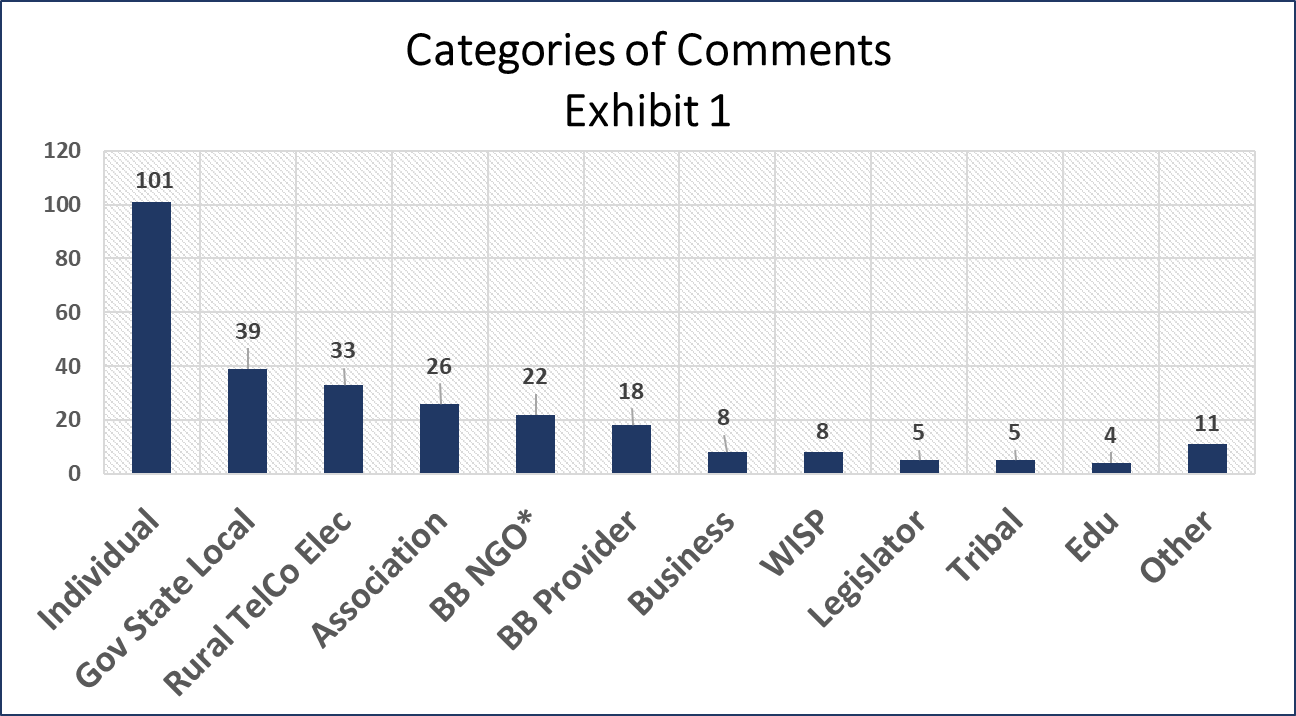 Comment
Categories:
Comment
Categories:
*
Community Based BB Advocates
Eligible Rural Area Factors
B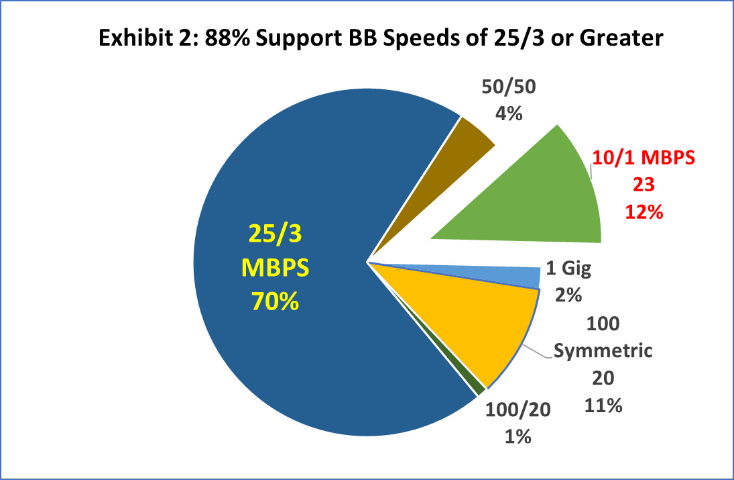 roadband
Speed, 83-percent of comments identified broadband speed as
important. 88-percent of those who
specifically commented on speed felt that 25/3 mbps or higher should
be the speed criterion defining served. Most felt that 10/1
mbps was too slow and that USDA should be consistent with the FCC
25/3 mbps standard. Other comments suggest that upload speed,
latency and synchronous speeds should also be broadband criterion.
See Exhibit 2.
roadband
Speed, 83-percent of comments identified broadband speed as
important. 88-percent of those who
specifically commented on speed felt that 25/3 mbps or higher should
be the speed criterion defining served. Most felt that 10/1
mbps was too slow and that USDA should be consistent with the FCC
25/3 mbps standard. Other comments suggest that upload speed,
latency and synchronous speeds should also be broadband criterion.
See Exhibit 2.
Affordability, defined as cost of monthly service or cost to connect home to the nearest fiber was raised by two thirds of comments. Many of the comments suggested that affordability be included in the definition of unserved. The cost to connect to the nearest fiber was described as a barrier to broadband access. Many individual comments expressed frustration over the refusal of incumbent providers to connect them to higher speed broadband without high connection charges. See Exhibit 3.
R
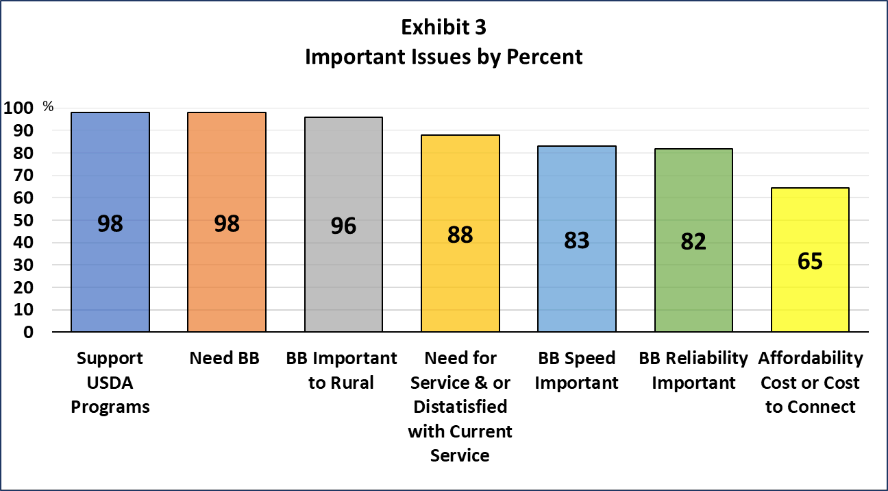 eliability,
is as important as broadband speed, according to 82-percent of
comments. Some felt that a reliability metric should be
included in the definition of “unserved”
and broadband capacity. Another metric suggested is Rural Urban
broadband equivalency. Broadband reliability is critical from a
business, telehealth and public safety emergency communication
perspective. The spread of virtual at home employment raises the
importance of business tier reliable broadband to the home. See
Exhibit 3.
eliability,
is as important as broadband speed, according to 82-percent of
comments. Some felt that a reliability metric should be
included in the definition of “unserved”
and broadband capacity. Another metric suggested is Rural Urban
broadband equivalency. Broadband reliability is critical from a
business, telehealth and public safety emergency communication
perspective. The spread of virtual at home employment raises the
importance of business tier reliable broadband to the home. See
Exhibit 3.
F
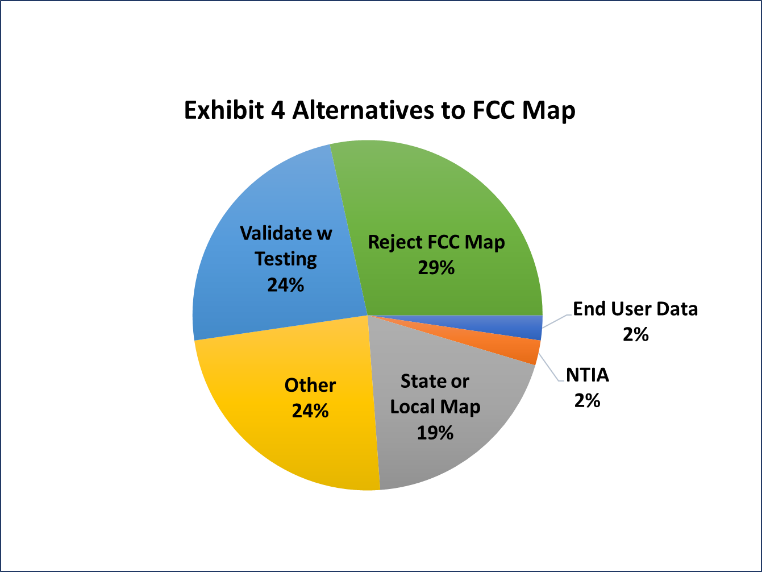 CC
Mapping or Testing: 52-percent of comments on the FCC
broadband maps rejected using it for determination of
broadband service. The remainder made no comment. Of those who
mentioned broadband mapping, 28-percent explicitly rejected the FCC
map with no alternative suggested. 24-percent suggested validating
with testing. These comments also complained that telecommunications
companies were inaccurate or misleading in their claim of service.
19-percent suggested using state or local maps as a more accurate
alternative. The California Public Utilities Commission offers its
broadband map as more substantive and granular. Two-percent
suggested using NTIA maps or end user data. Twenty-four-percent had
a broad range of different ideas for better mapping alternatives to
the FCC map. Commenters felt that the FCC methodology was flawed by
(1) using Census Blocks which over represents service in rural areas,
and (2) reliance on the advertised speeds from telecommunications
companies. They suggest focusing on measuring the gap between
advertised speeds available and speeds delivered; and
testing for broadband service during peak periods of usage
will help establish more accurate real world broadband maps. See
Exhibit 4.
CC
Mapping or Testing: 52-percent of comments on the FCC
broadband maps rejected using it for determination of
broadband service. The remainder made no comment. Of those who
mentioned broadband mapping, 28-percent explicitly rejected the FCC
map with no alternative suggested. 24-percent suggested validating
with testing. These comments also complained that telecommunications
companies were inaccurate or misleading in their claim of service.
19-percent suggested using state or local maps as a more accurate
alternative. The California Public Utilities Commission offers its
broadband map as more substantive and granular. Two-percent
suggested using NTIA maps or end user data. Twenty-four-percent had
a broad range of different ideas for better mapping alternatives to
the FCC map. Commenters felt that the FCC methodology was flawed by
(1) using Census Blocks which over represents service in rural areas,
and (2) reliance on the advertised speeds from telecommunications
companies. They suggest focusing on measuring the gap between
advertised speeds available and speeds delivered; and
testing for broadband service during peak periods of usage
will help establish more accurate real world broadband maps. See
Exhibit 4.
T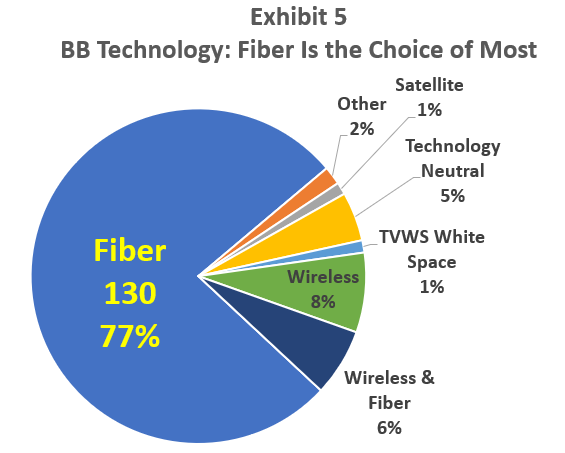 ype
of Broadband Technology: Fiber to the home is supported by
77-percent of those who expressed a view point. This is a diverse
group that includes individuals, businesses, rural electrics,
broadband providers. Interestingly, National Grange and the Western
Governors Association are advocates of whitespace technology because
of its potential to connect broadband to farm fields, also advocated
by Microsoft. See Exhibit 5.
ype
of Broadband Technology: Fiber to the home is supported by
77-percent of those who expressed a view point. This is a diverse
group that includes individuals, businesses, rural electrics,
broadband providers. Interestingly, National Grange and the Western
Governors Association are advocates of whitespace technology because
of its potential to connect broadband to farm fields, also advocated
by Microsoft. See Exhibit 5.
| File Type | application/vnd.openxmlformats-officedocument.wordprocessingml.document |
| File Title | Highlights of Rural e-Connectivity Pilot Program Comments |
| Author | Tse, Robert - RD, Davis, CA |
| File Modified | 0000-00-00 |
| File Created | 2021-01-20 |
© 2025 OMB.report | Privacy Policy